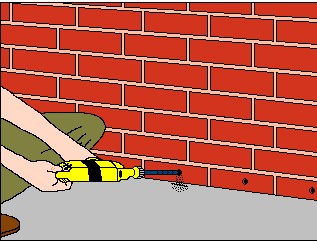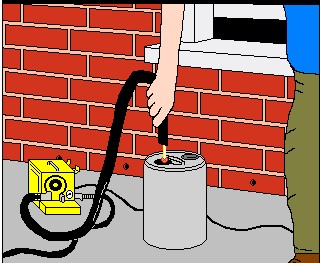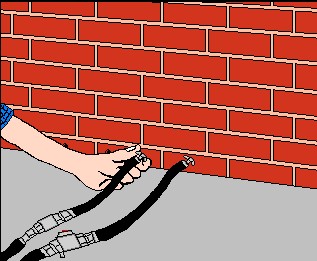Chemical damp proof courses have become very popular, personally I prefer the electro osmosis method as it is far easier and cleaner but here is how a chemical damp proof course would be installed. Firstly you are going to have to realise that this can be quite a big job and could seem overwhelming, before starting work ensure that you are up to the job and if you feel it is too big a job then it is best to enlist a builder or specialist company to do it for you.
- Essentially a chemical damp proof course is simply a waterproofing chemical (often silicone) which is injected into the bricks. As the bricks are porous they soak up the chemical and retain it. Once the brick is saturated it can no longer absorb water and so you have a effective damp proof course.
- If the property is badly effected by damp, then the plaster will of perished and the skirting boards could be rotten. The skirting boards need removing and any effected plaster needs removing to at least 18 inches above the effected area. Remove any radiators from the walls and switch off the electricity to sockets in the area, a extension lead will be required from either next door or a circuit well away from where you are working!
- Holes are to be drilled in both the inside wall of the property and the outside wall, this can be done from inside of the property by using two different length injection nozzles. Here we are going to drill from the inside only as the wall is solid, cavity walls need injecting from both sides.
- If holes are drilled on the outside of the property, they need leaving as long as possible before being plugged with mortar containing a waterproofing agent. Inside the wall needs leaving for about a month per inch of thickness of the wall! This is why I prefer the electro osmosis method.
- DPC injection machines can be hired for the weekend, the hire company will advise you on the amount of fluid needed and the correct size of drill to use etc.

Holes need drilling just above floor level if you have a solid floor or below the floor level if the floor is wood, this can make it difficult as the floorboards will need lifting. Drill the correct size holes for the injection nozzles and space the holes about 4 1/2 inches apart. Drill the holes 3 inches deep and angle the drill downwards. It is a good idea to drill all of the holes at once before you start injecting the DPC chemical.

The suction end of the machine should be placed in the DPC solution, these are normally 25 litre drums. It is a good idea to wear some good quality rubber gloves and goggles when using one of these machines.

Insert the injection nozzles and connect them to the injection machine, leaving one nozzle unconnected, open all the valves on the machine and switch it on, holding the nozzle that is not connected to the tapered plugs over a bucket to bleed the system. Now close this valve and fit it to the tapered plug and reopen the valve, the machine should now be pumping the fluid into the bricks. The surface of the bricks will darken as they become saturated, once this happens turn off the valves and move the nozzles along to the next bricks to be injected. Repeat this process until all the bricks have been saturated.

Because this wall is 9 inches thick it now needs drilling with a longer drill bit, to a depth of 7 1/2 inches, through the existing holes. Using the longer injection nozzles inject the wall again as you did earlier, repeat until the hole wall is treated.



